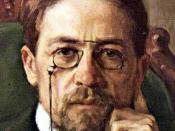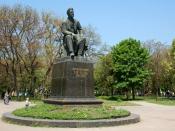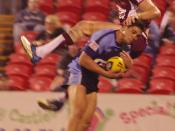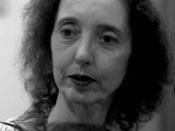Born Again: A Comparison of Two Tales of "The Lady with the Pet Dog" by Anton Chekhov and Joyce Carol Oates While the topics of love lost and hope reborn are common themes in literature, Anton Chekhov and Joyce Carol Oates tell two unconventional tales of love lost, and then born again in their versions of "The Lady with the Pet Dog". Reaching across time, culture and two continents, Chekhov and Oates tell tales of hidden love that reach deep into the lives, fears and hopes of married men and women who struggle to reach beyond their unfulfilling and loveless marriages to find love, hope and acceptance from others.
In Chekhov's version, we read the story of Dmitry Gurov, a middle-aged married man who meets young Anna Sergeyevna, while both are vacationing alone in the 19th century Russian resort town of Yalta. Oates updates this tale with her version, telling the story of Anna and a man only identified as "the stranger" who meet in modern-day Nantucket, Massachusetts.
Chekhov's version is straightforward, proceeding from the beginning, where Dmitry and Anna meet and follows as their relationship grows. However, Oates writes a more roundabout version, starting in the middle of the affair, and then coming back to the beginning, and then back to the present, forcing the reader must follow the trail of events more closely in Oates' story. In spite of the time and cultural differences between the two versions, a similar pattern of events reveals itself.
Finding they have married women they feel are less "worldly" and educated than they are, the men in both stories have found themselves in unhappy marriages, where they become unable to relate to their spouses and grow apart from them. The "stranger" in Oates' version tells how his wife had inherited a classic painting, only to want to "touch it up a little". He also views his wife as a "neurotic" woman who uses his children against him. Dmitry considers his wife "of limited intelligence, narrow-minded and dowdy" and Chekhov describes her as one who "read a great deal", but "used simplified spelling in her letters".
An unhappy marriage, coupled with a long history of affairs gone badly, has soured Dmitry's outlook on women. From his experiences, he has come to hold a low opinion of women, calling them "the inferior race". In spite of these bad experiences and the negative opinions of women that have resulted from them, Dmitry continues to pursue more extramarital affairs, finding he is able to communicate with most women more freely than his own wife or other men he knows. Even when he meets Anna Sergeyevna, he remarks to himself how "There's something pathetic about her". Similarly, long years in a bad marriage have disillusioned Anna, the main character in Oates' story, who confesses that her husband and her parents "were all people I believed in, but it turned out all wrong".
In both stories, the Annas find themselves trapped in marriages to husbands who have successful careers that allow them to provide financial security for their wives, but who take little interest in their personal well beings. In return, neither of the Annas takes much interest in their husbands' careers. In Oates' version, Anna's husband is described a hard-working businessman who spends a lot of time working at his plant, to the point of falling asleep at the table at home. While he talks at length about his job, his wife often pays little attention to what he says. Anna Sergeyevna isn't even sure exactly what her husband does for a living, except to say that he "was a member of a Government Board or served on a Zemstvo Council".
Both Annas are confronted with feelings of guilt about their affairs, but also hold feelings of guilt for having to keep appearances to maintain their unhappy marriages. Chekhov's Anna describes herself to Dmitry as "a bad, low woman", who confesses, "I despise myself". Oates' Anna is described as "noiseless and convincing, like a dancer performing certain steps" who laments "this is fate ⦠to be here and not there, to be one person and not another". Seeking to relieve her internal conflicts over an affair that she does not want to end, she wishes that "one of them would die" and even experiments at cutting herself, hoping to find the courage to inflict enough of a wound to kill herself.
In time, all four secret lovers overcome their feelings of disappointment, self-loathing and fear to find love and happiness in each other. Oates' Anna overcomes her suicidal desires, finally embracing her lover as "her truest lover, her destiny", while Chekhov's Anna and Dmitry secret relationship grew to the point where they "loved each other as people do who are very close and intimate".
In both versions of "The Lady with the Pet Dog", Anton Chekhov and Joyce Carol Oates write of people who have lost love and hope in their lives. Their characters struggle to overcome their feelings of fear, guilt, pessimism, self-loathing and indifference to reach out to each other and escape their unhappy marriages. These stories reach across time, distance and culture to tell tales of people who, find similar, yet unconventional, paths to finding new hope and love in their lives.





